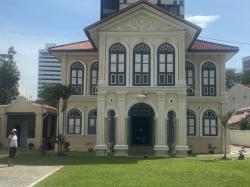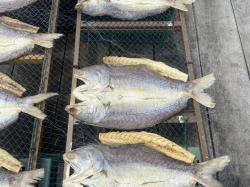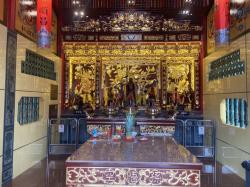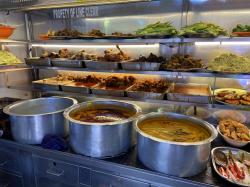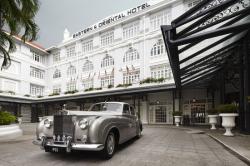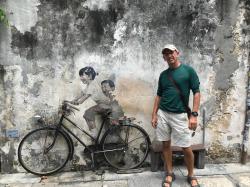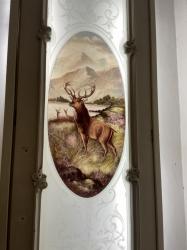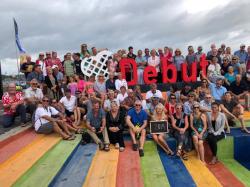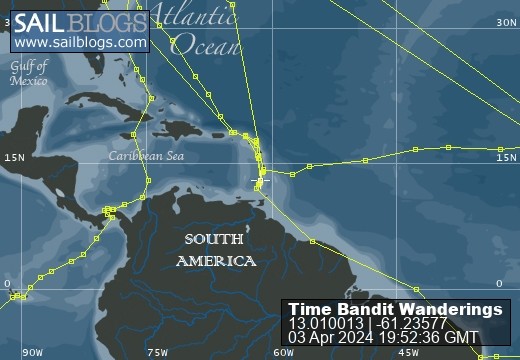
Time Bandit
It’s back to the Caribbean leaving a chilly USA east coast for the winter months in the sun.
03 April 2024
24 March 2024
04 March 2024
14 February 2024
01 February 2024
15 December 2023
06 December 2023
23 November 2023
18 November 2023
17 November 2023
15 November 2023
10 November 2023
09 November 2023 | Norfolk VA
22 October 2023
20 October 2023 | New York Sail Past
29 September 2023
07 September 2023
20 August 2023
15 August 2023
05 August 2023
Cruising On A Budget
03 April 2024
Stuart Letton
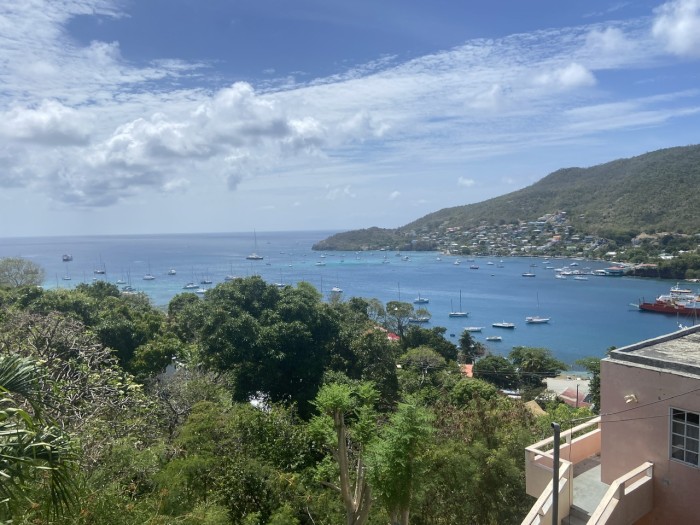
Nearly fifteen years ago now we used to browse the bookshelves of Largs Chandlers, looking for pearls of wisdom that might help us in our anticipated cruising lifestyle, even though, at the time, it was still on a distant horizon as we were still “working class”. Fortunately, we had been slowly getting prepared and doing the essential preparation as events conspired to precipitate an earlier than anticipated transition from working class to retired class, (for more details, see my Forthcoming Book, which, as some readers will know, has been forthcoming for many years).
One book I recall, was something like Cruising On A Budget, brackets You Really Can Cruise The World On Just Twenty Quid!
Real life experience proved that this concept was a complete and utter daydream. We bought a shackle yesterday, the previous one having got bent out of shape and rendered useless. $36 of your American dollars. Just checking in to St Vincent and the Grenadines, two hundred and fifty of your Eastern Caribbean dollars.
Nonetheless, there do appear to be a number of people trying to live up to the twenty quid ethic. I mean, just this morning, here in the anchorage in Bequia, there’s a poor girl on the foredeck of the boat anchored just behind us who can’t even afford the top half of her bikini. More worryingly, there’s a silver bearded old guy anchored to port who can’t even afford the bottom half.
Aaaargh……
One book I recall, was something like Cruising On A Budget, brackets You Really Can Cruise The World On Just Twenty Quid!
Real life experience proved that this concept was a complete and utter daydream. We bought a shackle yesterday, the previous one having got bent out of shape and rendered useless. $36 of your American dollars. Just checking in to St Vincent and the Grenadines, two hundred and fifty of your Eastern Caribbean dollars.
Nonetheless, there do appear to be a number of people trying to live up to the twenty quid ethic. I mean, just this morning, here in the anchorage in Bequia, there’s a poor girl on the foredeck of the boat anchored just behind us who can’t even afford the top half of her bikini. More worryingly, there’s a silver bearded old guy anchored to port who can’t even afford the bottom half.
Aaaargh……
What Would Grandad Think?
24 March 2024
Stuart Letton
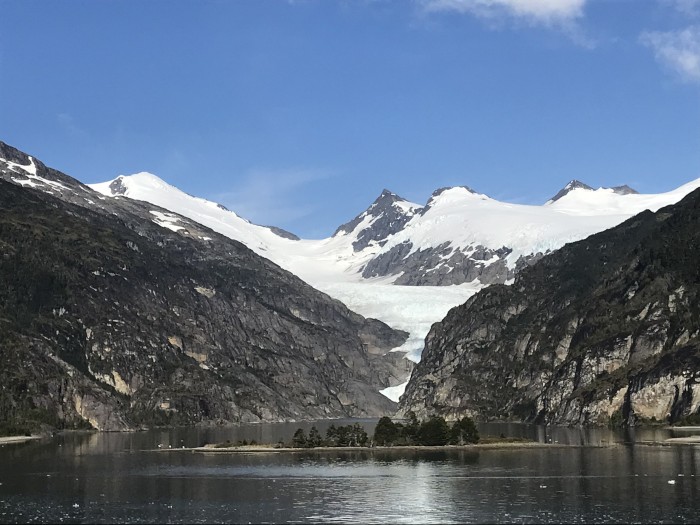
We continue faking it through Patagonia, dressing in our bike jeans to go for a walk on the beach, chatting up real high latitude cruisers and “Cape Horners” then …… there’s these wild horses.
Faking It
04 March 2024
Stuart Letton
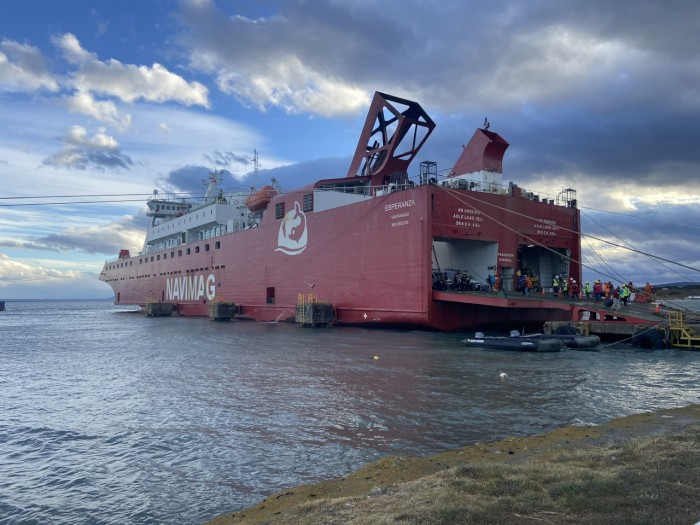
"Where are you going now? We'll be late." said she, exasperated.
"I'm going out to the garage" came back the reply from Mr Grumpy.
"Whatever for?"
"My jacket."
"Your jacket's right here at the front door."
"No, I want my Musto jacket."
"For heaven's sake, it's the boat show we're going to, not the Fastnet."
Sound familiar?
If you've ever been to a boat show, I'm sure you'll have recognised the fact that many attendees wear what you might call, "industry relevant clothing." Boat show folk wear their old Mustos and Henri Lloyds. Agricultural Show visitors wear their Barbours and Hunter wellies. Motorcyclists wear their Ducati leathers or BMW Adventure jackets.
Well, we're feeling a bit like that just now, walking around the streets and the decks of assorted ferries and "expedition" cruise ships in our motorcycle gear when said bike is tucked up in storage a thousand miles away. Top Tip: don't go on an eight mile hike wearing your three layer, Kevlar lined, motorcycle jeans just because it looked a bit cloudy. Phew. Even my knees were perspiring.
When we stroll past bikers all togged up in our gear, whether on the ferry or on the street, we can exchange a knowing nod and fake it as rufty, tufty bikers. Not that we've much choice as it's about all the clothes we've got. That and it makes me feel a bit less like I'm on a Wallace Arnold tour. The funny thing is, our fellow travellers aren't of that genre. Half of them are "kids" half our age, all long hair, tattoos and piercings who should really be at work, paying taxes to fund the pensions and health costs of folk like us. We don't think we like them.
Then, there's the other half. They're more our age, out blowing the kids inheritance, seeing the world, but annoyingly look twice as fit as we do. Two of them are wearing Ironman T-shirts. We really don't like them.
Our plan for South America always included a ferry trip as part of our recce to see if bringing Time Bandit, our lightweight, performance, cruising catamaran down here to the Roaring Forties and Furious Fifties was entirely sensible.
Having been brought up in and around the River Clyde, ferries and ferry trips are nothing new. On our summer holiday to Arran we'd have a mini cruise on the Glen Sannox car ferry from Ardrossan to Brodick feeding the seagulls with stale bread we'd collect in the week or so before heading off on the big trip.
In all these trips, I don't ever recall having a safety briefing. However, aboard the Navimag, we were all summoned to the restaurant where the captain gave us his safety talk.
"Good morning" he says, "Firstly, this is a three day trip. On the first day get you get used to the ship. On the second day you get sea sick and on the third you recover. And' he stressed, "No Jack and Rose at the bow a la Titanic and finally, if you see me with a lifejacket on and running; follow me."
As always, if there's nothing on the tele, this might help pass a few minutes.......
"I'm going out to the garage" came back the reply from Mr Grumpy.
"Whatever for?"
"My jacket."
"Your jacket's right here at the front door."
"No, I want my Musto jacket."
"For heaven's sake, it's the boat show we're going to, not the Fastnet."
Sound familiar?
If you've ever been to a boat show, I'm sure you'll have recognised the fact that many attendees wear what you might call, "industry relevant clothing." Boat show folk wear their old Mustos and Henri Lloyds. Agricultural Show visitors wear their Barbours and Hunter wellies. Motorcyclists wear their Ducati leathers or BMW Adventure jackets.
Well, we're feeling a bit like that just now, walking around the streets and the decks of assorted ferries and "expedition" cruise ships in our motorcycle gear when said bike is tucked up in storage a thousand miles away. Top Tip: don't go on an eight mile hike wearing your three layer, Kevlar lined, motorcycle jeans just because it looked a bit cloudy. Phew. Even my knees were perspiring.
When we stroll past bikers all togged up in our gear, whether on the ferry or on the street, we can exchange a knowing nod and fake it as rufty, tufty bikers. Not that we've much choice as it's about all the clothes we've got. That and it makes me feel a bit less like I'm on a Wallace Arnold tour. The funny thing is, our fellow travellers aren't of that genre. Half of them are "kids" half our age, all long hair, tattoos and piercings who should really be at work, paying taxes to fund the pensions and health costs of folk like us. We don't think we like them.
Then, there's the other half. They're more our age, out blowing the kids inheritance, seeing the world, but annoyingly look twice as fit as we do. Two of them are wearing Ironman T-shirts. We really don't like them.
Our plan for South America always included a ferry trip as part of our recce to see if bringing Time Bandit, our lightweight, performance, cruising catamaran down here to the Roaring Forties and Furious Fifties was entirely sensible.
Having been brought up in and around the River Clyde, ferries and ferry trips are nothing new. On our summer holiday to Arran we'd have a mini cruise on the Glen Sannox car ferry from Ardrossan to Brodick feeding the seagulls with stale bread we'd collect in the week or so before heading off on the big trip.
In all these trips, I don't ever recall having a safety briefing. However, aboard the Navimag, we were all summoned to the restaurant where the captain gave us his safety talk.
"Good morning" he says, "Firstly, this is a three day trip. On the first day get you get used to the ship. On the second day you get sea sick and on the third you recover. And' he stressed, "No Jack and Rose at the bow a la Titanic and finally, if you see me with a lifejacket on and running; follow me."
As always, if there's nothing on the tele, this might help pass a few minutes.......
The Vomit Comet
14 February 2024
Stuart Letton
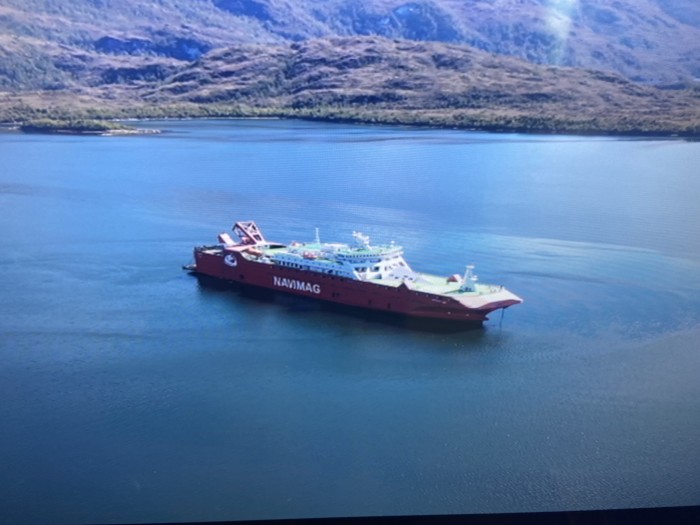
Many, many years ago, decades in fact, we went on a cross (English) channel, pre-Christmas trip to load up on cheap French booze.
The trip was organised by Anne's work and we left in a tourist coach before dawn on a cold, grey and winter's morning from Slough, a picturesque fishing village about thirty miles west of London. We left early in order to catch the morning ferry giving enough time for a lunch of langoustine and frites plus load up on booze.
Two hours or so later we arrived at Dover ferry terminal to be told all ferries were cancelled owing to high seas and gale force winds......... all ferries that is, other than ours.
Around eleven, our little ferry boldly thrust its way onto the dock and started unloading.
First there was the Christmas tree truck. It was pulled out on its side in a shower of sparks, dragging hundreds of trees in the ramp in its wake. Once these had been swept away, the totally flattened Rover 2000 that the truck landed on was dragged out.
This somewhat alarming sight went on for about an hour until, decks cleared, we were gaily ushered on board.
Now, as it was lunchtime and few had eaten since the crack of dawn, the majority headed straight for the cafeteria where they stuffed Full English, toast, tea and coffee down their gobs before heading for the duty free. As I recall, a jolly nice Full English it was .....but then, I don't suffer from sea sickness.
No sooner had we hit the first swells outside the harbour than most everyone turned green and started filling their plastic Duty Free carrier bags with their Full English.
And so, here we are in Puerto Montt, sat in the cafeteria of the good ship, Esperanza, still tied to the dock, everyone stuffing roast chicken and veg down their throats and, just around the corner is the Pacific Ocean and the Roaring Forties where yesterday it was blowing fifty knots!
This is going to be interesting.
The trip was organised by Anne's work and we left in a tourist coach before dawn on a cold, grey and winter's morning from Slough, a picturesque fishing village about thirty miles west of London. We left early in order to catch the morning ferry giving enough time for a lunch of langoustine and frites plus load up on booze.
Two hours or so later we arrived at Dover ferry terminal to be told all ferries were cancelled owing to high seas and gale force winds......... all ferries that is, other than ours.
Around eleven, our little ferry boldly thrust its way onto the dock and started unloading.
First there was the Christmas tree truck. It was pulled out on its side in a shower of sparks, dragging hundreds of trees in the ramp in its wake. Once these had been swept away, the totally flattened Rover 2000 that the truck landed on was dragged out.
This somewhat alarming sight went on for about an hour until, decks cleared, we were gaily ushered on board.
Now, as it was lunchtime and few had eaten since the crack of dawn, the majority headed straight for the cafeteria where they stuffed Full English, toast, tea and coffee down their gobs before heading for the duty free. As I recall, a jolly nice Full English it was .....but then, I don't suffer from sea sickness.
No sooner had we hit the first swells outside the harbour than most everyone turned green and started filling their plastic Duty Free carrier bags with their Full English.
And so, here we are in Puerto Montt, sat in the cafeteria of the good ship, Esperanza, still tied to the dock, everyone stuffing roast chicken and veg down their throats and, just around the corner is the Pacific Ocean and the Roaring Forties where yesterday it was blowing fifty knots!
This is going to be interesting.
Patagonia Eps 1
01 February 2024
Stuart Letton
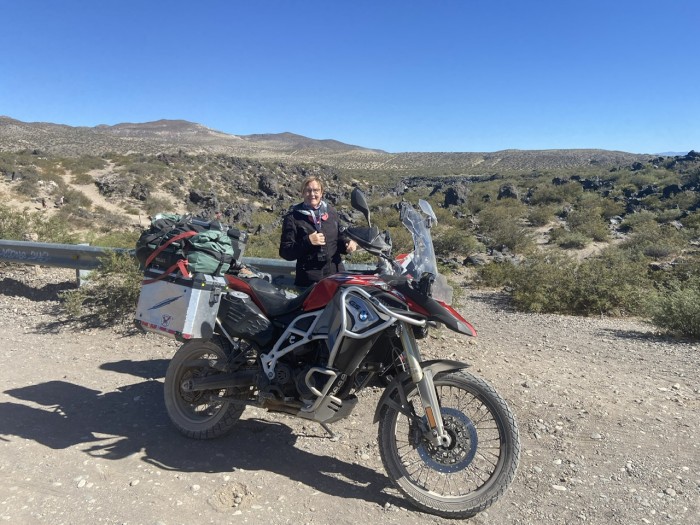
Some blog followers will know we quite like hooning around on motorcycles when we get the chance.
Our motorcycle tours generally happen during the hurricane or cyclone enforced off-seasons although for nine months from November '21 through until August '22 we had an epic time riding over 17,000 kilometres around South and Southern Africa, much of it off-road......and so the seed was sown.
Over the course of the one hundred and eighty seven nights we spent at anchor last autumn, the idea slowly germinated.
One hundred and eighty seven nights. That's a lot of guitar practice but more honestly, a lot of YouTube. And it's surprising what you can find down that Internet worm hole. Take your choice from a selection of wars, the antics of slippery politicians and, fortunately, sailing channels of people cruising the Beagle Channel and off-road motorcycle touring.
We have always toyed with the idea of sailing way down south to penguin land but, not only is it a long way, but every night, having found a sheltered but totally desolate, rocky and kelp strewn caleta, we'd have to launch the dinghy and one of us, probably Anne, row ashore to tie up the boat in a spiders web of rope. All while it's blowing seventy knots. Not many peoples idea of fun, least of all ours.
After scary nights in these caletas we'd no doubt arrive in one of the few ports down there where we'd be anchoring or rafting our beautiful, racy, plastic fantastic amongst the rufty, tufty steel and aluminium boats that frequent these waters. No doubt this would draw some critical looks and clearly audible "tutt, tutts" with the odd "harrumph". It would be like going to a heavy metal concert dressed in tutu.
However, is it really that bad? I've read of people doing the Beagle Channel in twenty seven foot, 1970's Albin Vegas and I've seen pictures of a cruising catamaran in one of the aforementioned caleta, albeit showing a decidedly bracing 06c in the cabin.
No doubt, quite soon, some yoof will round the Horn on a foiling kite board or jet-ski giving that weird pinky and thumb wave, so loved by both that generation and embarrassingly by those of an older generation who should know better. You can tell them even without the funny wave, they'll call you, "dude" and if you ever get close enough to shake hands it will be more like thumb wars as they try to give you the dudes version of a Masonic handshake.
Anyways, dudes, the problem we faced was how could we see the sailing conditions for ourselves and find out first hand what it was like without flogging all the way through the Canal and thousands of miles offshore to the frozen south in Time Bandit.
And so the idea to use a motorcycle to do a recce of the miseries of sailing down to Ushuaia was born. Well, the recce thing was just a fortunate and convenient excuse. I really did fancy riding the classic Ruta Cuarenta and Caraterra Austral routes through Patagonia.
I won't bore you with the complexities and bureaucracy of buying a vehicle in Chile. Just trust me. Don't even think about it. If you must do it; rent.
Firstly, last autumn, we had to head to the Chilean embassy in Washington to get the essential, personal RUT identity number before we could even think about buying some wheels, but in the end, after four visits and two tellings off, we got it.
We landed in Santiago on 29th December and had the pleasures of two weeks faffing around at motorcycle dealers, agents and notaries. Two full weeks it took, but finally we were ready. Until we found we'd been sold, or I bought, a "lemon". Firstly a major steering problem needing a new bearing then new fork seals. "Oh, didn't you read the Spanish small print, section 2b, saying suspension wasn't covered?"
That cost another three or four days and about a million or two pesos but finally we moved the bike out of the hotel garage and onto the street. We carted all our gear from the room and loaded our luggage for an anticipated three months touring into the three aluminium panniers. Luggage plus tools and spares for self sufficient maintenance if punctured off-road in the wilds, along with the tent, tent poles, ground sheet and tiny cook set. All loaded up and just as the bike had finally taken on the look of a true, off-road adventure tourer, Anne climbed on....... and the whole flippin' lot slowly and elegantly fell over in the street.
Out went all the camping gear. Tools were limited to the essentials and clothing pared to an embarrassing and potentially smelly minimum.
Finally, having shed some weight, we got saddled up, wobbled our first few hundred metres up the road and made the first eighty kilometres to Los Andes in the foothills of...... the Andes.
Waking to a bright blue sky we eagerly set off through the dusty villages heading for the hills and the border crossing to Argentina. Up and up we went round endless hairpins, climbing to nearly three thousand metres before arriving at the border checkpoint......and a two hour customs and immigration process. Fortunately, years of going through the same tedious clearing in and out process with the boat had prepared us for this usual nonsense. Finally clear of the border checkpoint we wound our way down the eastern side of the Andes onto the dusty plains and dustier villages of Argentina.
We spent the night in a very comfy cabana and next morning started heading southwards. Five hundred miles later, in the sleepy mining town of Zapala we hit a major problem.
Our fuel ejection system totally packed up. Three days treatment at the local service centre seemed to get things moving again so we set off on the next five hundred miles through the stunning volcanic deserts, ravines and mountains before arriving once again at the Argentine / Chile border where we did the whole clear-in and out thing again, just going the other way.
The grand recce plan had been to get to Puerto Montt then catch the Navimag ferry to sail the seven or eight hundred miles through the Chilean archipelago to Puerto Natales. This would give us a good, close up look at the sailing conditions and, perhaps a look into the caletas where we'd possibly be frantically trying to row hundreds of metres of rope to tie onto a spindly tree onshore.
Unfortunately, the fuel ejection problem came back with a vengeance and another three days were lost while the problem was dealt with. On the advice of the head mechanic, our motorcycling trip was over. It had all just become a complete pain-in-the-ass. All that planning, jumping through the bureaucratic hoops and mental effort then, before even we got started on the Careterra Austral, the game was up. But we had a problem. We were motorcycle owners, as yet without transfer of ownership papers - these follow four to twelve weeks after money changes hands - and we were now a thousand miles south of Santiago, the most likely place we could sell the damn thing.
Thinking laterally, as this was a kind-of sailing inspired trip, we contacted Rachel at the Ocean Cruising Club HQ. Rachel then put us in touch with Eduardo, the Port Officer at Puerto Williams and home of the legendary but now, I think, abandoned Micalvi, haunt of many a Patagonian cruiser. With Eduardo's help we found Raúl who is going to look after the bike while we continue by ferry and bus.
Now, where's my white knitted cardigan?
YouTube: SV Time Bandit
Our motorcycle tours generally happen during the hurricane or cyclone enforced off-seasons although for nine months from November '21 through until August '22 we had an epic time riding over 17,000 kilometres around South and Southern Africa, much of it off-road......and so the seed was sown.
Over the course of the one hundred and eighty seven nights we spent at anchor last autumn, the idea slowly germinated.
One hundred and eighty seven nights. That's a lot of guitar practice but more honestly, a lot of YouTube. And it's surprising what you can find down that Internet worm hole. Take your choice from a selection of wars, the antics of slippery politicians and, fortunately, sailing channels of people cruising the Beagle Channel and off-road motorcycle touring.
We have always toyed with the idea of sailing way down south to penguin land but, not only is it a long way, but every night, having found a sheltered but totally desolate, rocky and kelp strewn caleta, we'd have to launch the dinghy and one of us, probably Anne, row ashore to tie up the boat in a spiders web of rope. All while it's blowing seventy knots. Not many peoples idea of fun, least of all ours.
After scary nights in these caletas we'd no doubt arrive in one of the few ports down there where we'd be anchoring or rafting our beautiful, racy, plastic fantastic amongst the rufty, tufty steel and aluminium boats that frequent these waters. No doubt this would draw some critical looks and clearly audible "tutt, tutts" with the odd "harrumph". It would be like going to a heavy metal concert dressed in tutu.
However, is it really that bad? I've read of people doing the Beagle Channel in twenty seven foot, 1970's Albin Vegas and I've seen pictures of a cruising catamaran in one of the aforementioned caleta, albeit showing a decidedly bracing 06c in the cabin.
No doubt, quite soon, some yoof will round the Horn on a foiling kite board or jet-ski giving that weird pinky and thumb wave, so loved by both that generation and embarrassingly by those of an older generation who should know better. You can tell them even without the funny wave, they'll call you, "dude" and if you ever get close enough to shake hands it will be more like thumb wars as they try to give you the dudes version of a Masonic handshake.
Anyways, dudes, the problem we faced was how could we see the sailing conditions for ourselves and find out first hand what it was like without flogging all the way through the Canal and thousands of miles offshore to the frozen south in Time Bandit.
And so the idea to use a motorcycle to do a recce of the miseries of sailing down to Ushuaia was born. Well, the recce thing was just a fortunate and convenient excuse. I really did fancy riding the classic Ruta Cuarenta and Caraterra Austral routes through Patagonia.
I won't bore you with the complexities and bureaucracy of buying a vehicle in Chile. Just trust me. Don't even think about it. If you must do it; rent.
Firstly, last autumn, we had to head to the Chilean embassy in Washington to get the essential, personal RUT identity number before we could even think about buying some wheels, but in the end, after four visits and two tellings off, we got it.
We landed in Santiago on 29th December and had the pleasures of two weeks faffing around at motorcycle dealers, agents and notaries. Two full weeks it took, but finally we were ready. Until we found we'd been sold, or I bought, a "lemon". Firstly a major steering problem needing a new bearing then new fork seals. "Oh, didn't you read the Spanish small print, section 2b, saying suspension wasn't covered?"
That cost another three or four days and about a million or two pesos but finally we moved the bike out of the hotel garage and onto the street. We carted all our gear from the room and loaded our luggage for an anticipated three months touring into the three aluminium panniers. Luggage plus tools and spares for self sufficient maintenance if punctured off-road in the wilds, along with the tent, tent poles, ground sheet and tiny cook set. All loaded up and just as the bike had finally taken on the look of a true, off-road adventure tourer, Anne climbed on....... and the whole flippin' lot slowly and elegantly fell over in the street.
Out went all the camping gear. Tools were limited to the essentials and clothing pared to an embarrassing and potentially smelly minimum.
Finally, having shed some weight, we got saddled up, wobbled our first few hundred metres up the road and made the first eighty kilometres to Los Andes in the foothills of...... the Andes.
Waking to a bright blue sky we eagerly set off through the dusty villages heading for the hills and the border crossing to Argentina. Up and up we went round endless hairpins, climbing to nearly three thousand metres before arriving at the border checkpoint......and a two hour customs and immigration process. Fortunately, years of going through the same tedious clearing in and out process with the boat had prepared us for this usual nonsense. Finally clear of the border checkpoint we wound our way down the eastern side of the Andes onto the dusty plains and dustier villages of Argentina.
We spent the night in a very comfy cabana and next morning started heading southwards. Five hundred miles later, in the sleepy mining town of Zapala we hit a major problem.
Our fuel ejection system totally packed up. Three days treatment at the local service centre seemed to get things moving again so we set off on the next five hundred miles through the stunning volcanic deserts, ravines and mountains before arriving once again at the Argentine / Chile border where we did the whole clear-in and out thing again, just going the other way.
The grand recce plan had been to get to Puerto Montt then catch the Navimag ferry to sail the seven or eight hundred miles through the Chilean archipelago to Puerto Natales. This would give us a good, close up look at the sailing conditions and, perhaps a look into the caletas where we'd possibly be frantically trying to row hundreds of metres of rope to tie onto a spindly tree onshore.
Unfortunately, the fuel ejection problem came back with a vengeance and another three days were lost while the problem was dealt with. On the advice of the head mechanic, our motorcycling trip was over. It had all just become a complete pain-in-the-ass. All that planning, jumping through the bureaucratic hoops and mental effort then, before even we got started on the Careterra Austral, the game was up. But we had a problem. We were motorcycle owners, as yet without transfer of ownership papers - these follow four to twelve weeks after money changes hands - and we were now a thousand miles south of Santiago, the most likely place we could sell the damn thing.
Thinking laterally, as this was a kind-of sailing inspired trip, we contacted Rachel at the Ocean Cruising Club HQ. Rachel then put us in touch with Eduardo, the Port Officer at Puerto Williams and home of the legendary but now, I think, abandoned Micalvi, haunt of many a Patagonian cruiser. With Eduardo's help we found Raúl who is going to look after the bike while we continue by ferry and bus.
Now, where's my white knitted cardigan?
YouTube: SV Time Bandit
Scratching That Patagonia Itch
15 December 2023
Stuart Letton
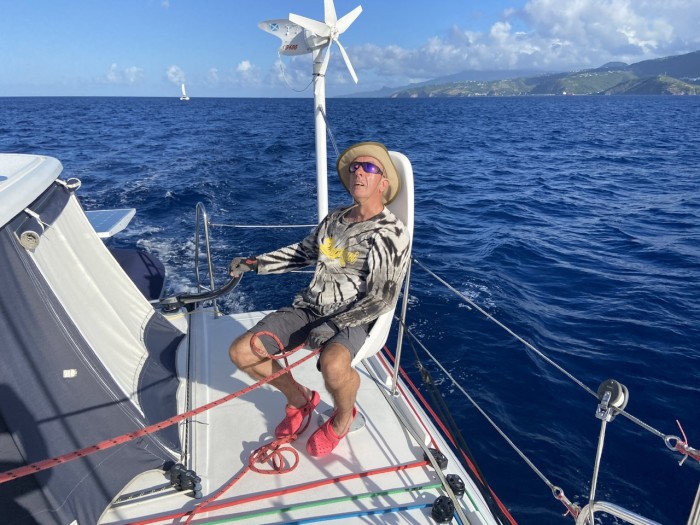
It’s been a long distance year, with nearly 7,000 miles under the bridge deck, Grenada to Nova Scotia and back, albeit not voluntarily, but that’s another story. However, finally, Time Bandit is on the hard.
A week of crash maintenance, scrubbing and polishing and Time Bandit is set for a rest, as are we….. but not sure we’ll get one. Grand winkies await.
It was a bit of a thrash down here to Grenada. Now we’ve got to thrash all the way back but this time, at least it’s in a 757.
After weve stuffed ourselves with Christmas turkey we’re going to stuff ourselves back into our Kevlar jeans, trade two hulls for two wheels and go for a hoon, as Trev would say, around Patagonia.
Seems like a good idea at the time.
A week of crash maintenance, scrubbing and polishing and Time Bandit is set for a rest, as are we….. but not sure we’ll get one. Grand winkies await.
It was a bit of a thrash down here to Grenada. Now we’ve got to thrash all the way back but this time, at least it’s in a 757.
After weve stuffed ourselves with Christmas turkey we’re going to stuff ourselves back into our Kevlar jeans, trade two hulls for two wheels and go for a hoon, as Trev would say, around Patagonia.
Seems like a good idea at the time.
06 December 2023
Stuart Letton
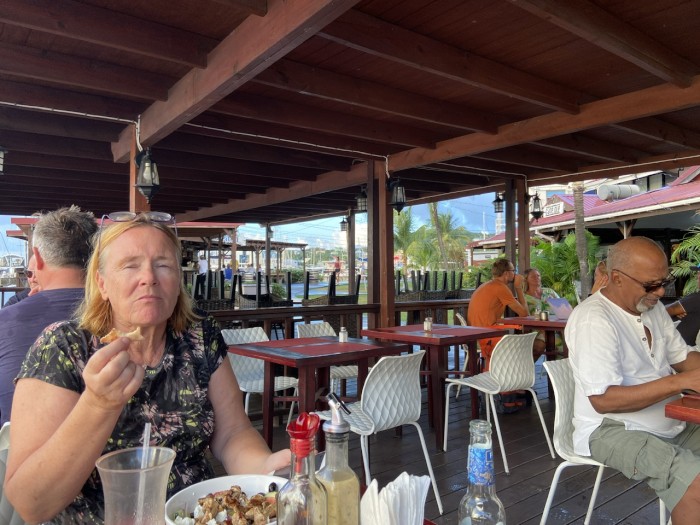
Water, water, everywhere........
South to New Zealand..... haven't you read about the Queens Birthday disaster? The Indian Ocean ..... ooohh, that's a scary place. Strong winds and giant seas. The Mozambique Channel? Ships get overwhelmed by simply enormous seas and are never seen again. Cape Town. Just mental katabatibc winds screaming down of Table Mountain. Mull of Kintyre? Well, enough said.
Let's just go to the Caribbean.
Look at the Moorings and Sunsail brochures. All blue skies, azure blue seas that barely ripple in the wafting, warm breezes. Whole families cavorting in the warm waters.
Jings, crivvens, help ma boab. What a trip. It's been punishing, exhausting and extremely wet. Mostly on the outside as, with all the leaping up and down climbing up, through and over big 'orrible breaking seas caused the fresh water sloshing about in our tanks to break off the uplift spigots inside the tanks. No fresh water from the taps for the last three days. It's a bit ripe on board.
The good news is that combining my limited electrical, mechanical, plumbing and bodge skills I was able to get it all going again. It was like Apollo 13, finding the problem then assembling bits of old crap to piece together a solution. If only they gave out O Levels for this ingenuity at school.
The end result is that tonight is shower night.
Two more stops and we're finally there.
Our Tracker (cut and paste).
https://forecast.predictwind.com/tracking/display/TimeBandit/
South to New Zealand..... haven't you read about the Queens Birthday disaster? The Indian Ocean ..... ooohh, that's a scary place. Strong winds and giant seas. The Mozambique Channel? Ships get overwhelmed by simply enormous seas and are never seen again. Cape Town. Just mental katabatibc winds screaming down of Table Mountain. Mull of Kintyre? Well, enough said.
Let's just go to the Caribbean.
Look at the Moorings and Sunsail brochures. All blue skies, azure blue seas that barely ripple in the wafting, warm breezes. Whole families cavorting in the warm waters.
Jings, crivvens, help ma boab. What a trip. It's been punishing, exhausting and extremely wet. Mostly on the outside as, with all the leaping up and down climbing up, through and over big 'orrible breaking seas caused the fresh water sloshing about in our tanks to break off the uplift spigots inside the tanks. No fresh water from the taps for the last three days. It's a bit ripe on board.
The good news is that combining my limited electrical, mechanical, plumbing and bodge skills I was able to get it all going again. It was like Apollo 13, finding the problem then assembling bits of old crap to piece together a solution. If only they gave out O Levels for this ingenuity at school.
The end result is that tonight is shower night.
Two more stops and we're finally there.
Our Tracker (cut and paste).
https://forecast.predictwind.com/tracking/display/TimeBandit/
23 November 2023
Stuart Letton
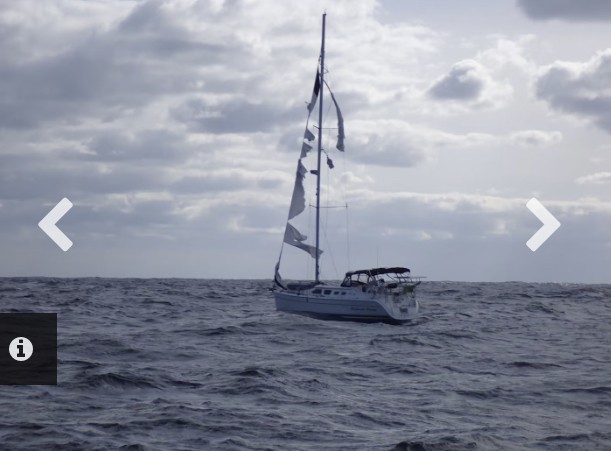
Here’s the latest video in which we go as slow as we can before going as fast as we can. As you’ve maybe read, we also come across a yacht reported overdue just before we left going even slower…….in some distress, sails in tatters, mid-ocean all in fairly boisterous conditions, not that you can really tell from the video, which goes to show just how much I’ve got to learn about photography.
Hope you like it nonetheless.
Hope you like it nonetheless.
| Vessel Name: | Time Bandit |
| Vessel Make/Model: | Outremer 51 |
| Hailing Port: | Largs, Scotland |
| Crew: | Anne and Stuart Letton |
| About: | ex dinghy and keelboat racers now tooled up with a super sleek cat and still cruising around aimlessly, destination Nirvana... |
| Extra: | Next up....the Caribbean. We've left South Africa in our wake and now off to Namibia, St Helena, Brazil, Suriname and into the Caribbean. Well, that' the vague plan. We'll see what happens. |
| Home Page: | http://www.sailblogs.com/member/timebandit/profile |
| Social: |
Time Bandit's Photos - Penang
The Crew
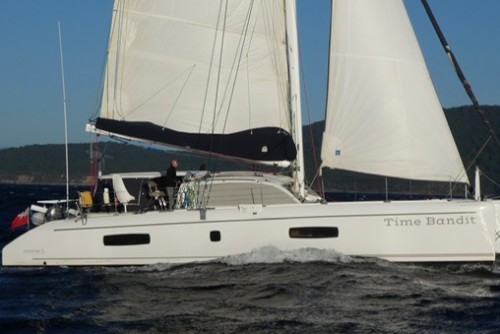
Who: Anne and Stuart Letton
Port: Largs, Scotland


